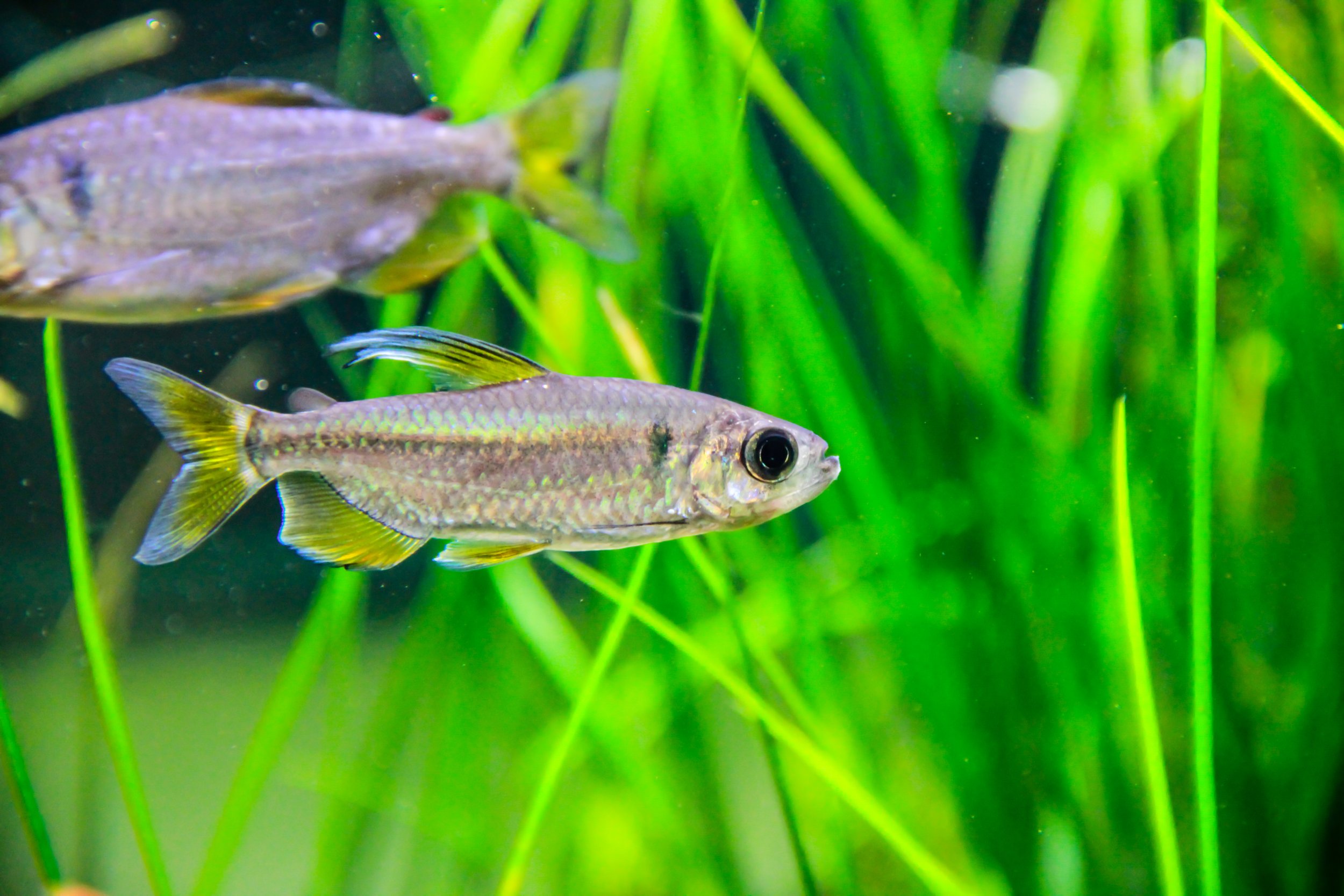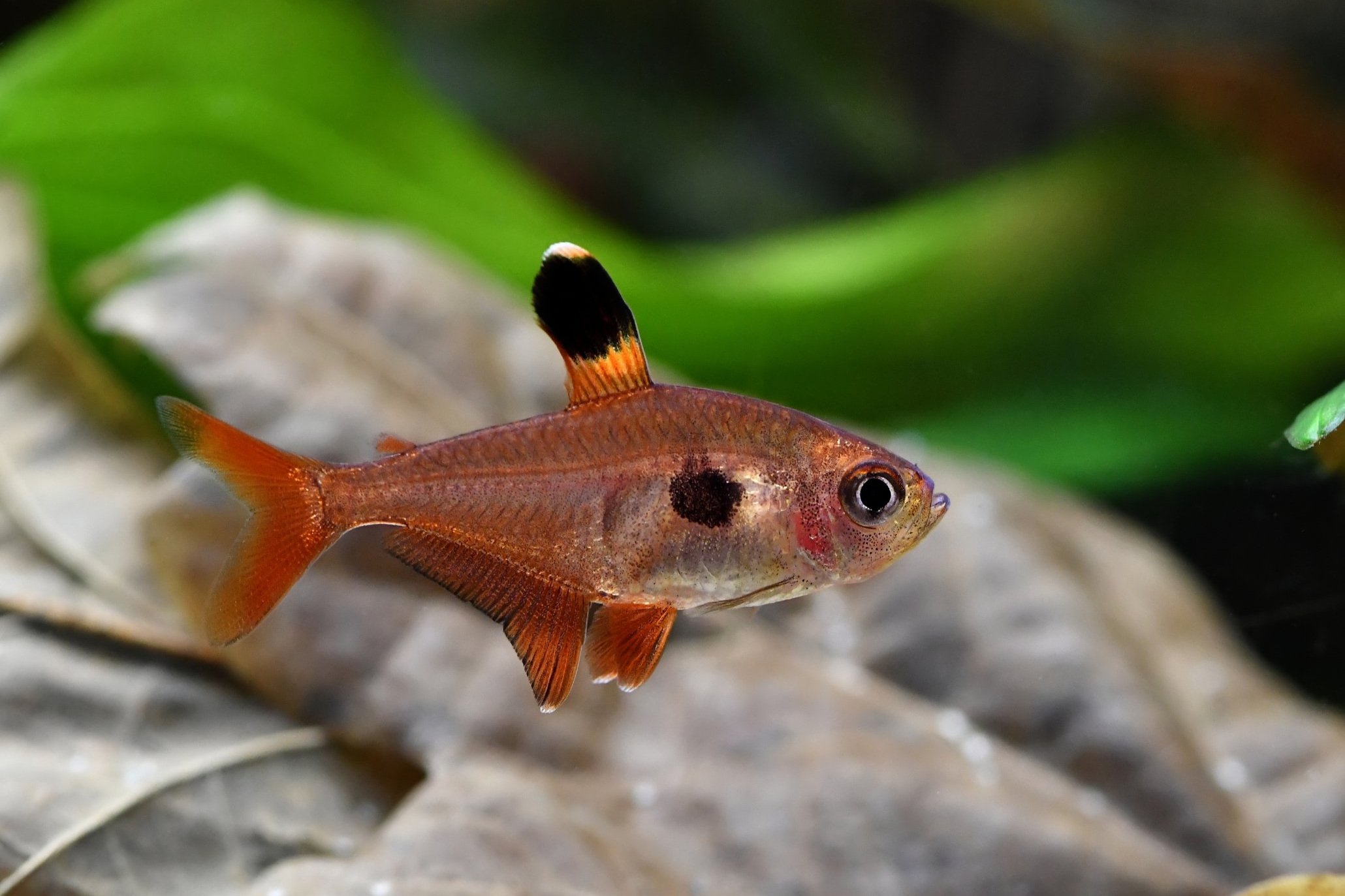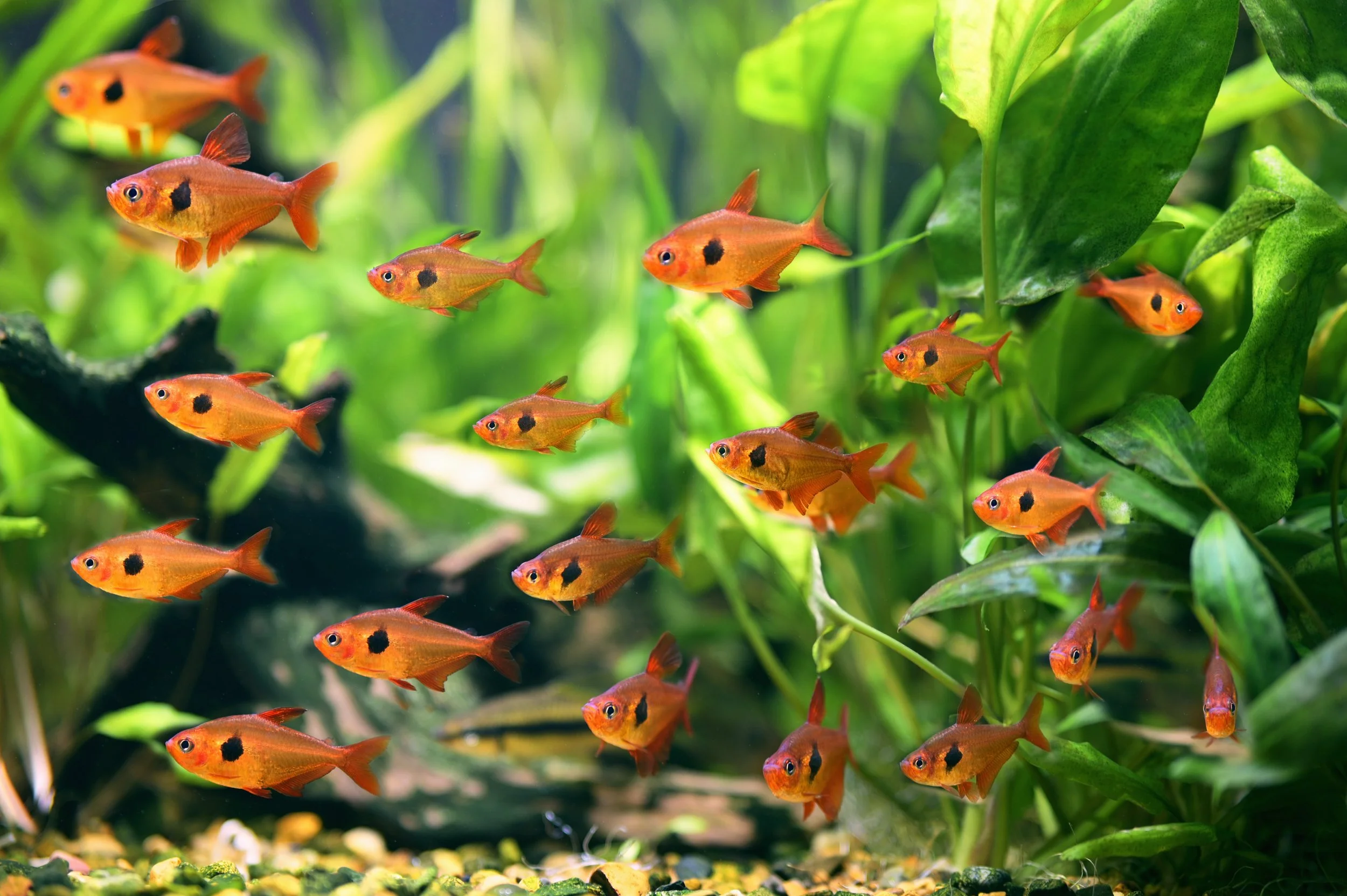 Image 1 of
Image 1 of


Tucano Tetra
The Tucano Tetra, scientifically known as Tucanoichthys tucano, is a rare and strikingly beautiful species of freshwater fish that has gained popularity among aquarists for its vibrant coloration and small size. Native to the Rio Uaupes region in the Amazon Basin of Brazil, near the territories of the Tucano people from whom it gets its name, this species thrives in blackwater environments characterized by soft, acidic water and dense vegetation. Its eye-catching appearance and unique behavior make the Tucano Tetra a desirable addition to specialized nano aquariums or biotope setups.
Physically, the Tucano Tetra is a small, slender fish that reaches only about 0.8 to 1 inch (2 to 2.5 centimeters) in length, making it ideal for nano tanks. What sets this tetra apart is its vibrant coloration: the body is a translucent silver or light golden color, with a striking black stripe running horizontally along the midline. Above the black stripe, a brilliant yellow or golden stripe adds a dramatic contrast, and the caudal fin is adorned with a touch of red, adding to its overall beauty. The fins are usually translucent with a slight yellow or red hue, especially in well-cared-for specimens.
In the aquarium, the Tucano Tetra thrives in a well-planted environment with plenty of hiding spots and subdued lighting to mimic its natural blackwater habitat. Floating plants are ideal as they provide cover and help diffuse light, creating a more natural environment for this shy species. Due to their peaceful and somewhat timid nature, they are best kept in groups of at least six to eight individuals, which encourages natural schooling behavior and helps reduce stress. They can be kept with other small, peaceful species, such as similarly sized tetras, rasboras, and shrimp, but care should be taken to avoid larger, more aggressive fish that could outcompete them for food.
Water parameters for the Tucano Tetra should closely resemble those of their natural blackwater environment. They prefer soft, acidic water with a pH range of 4.5 to 6.5 and temperatures between 75 to 82°F (24 to 28°C). The use of tannin-producing materials such as Indian almond leaves or driftwood is recommended to help create the slightly stained water that these fish are accustomed to. Maintaining clean, well-filtered water is essential, as these tetras are sensitive to fluctuations in water quality.
Feeding the Tucano Tetra can be a bit more challenging due to their small size and preference for live or frozen foods. They thrive on a varied diet that includes tiny live or frozen foods such as baby brine shrimp, daphnia, and micro-worms. They may also accept high-quality micro-pellets or crushed flakes, but live or frozen foods should make up a significant portion of their diet to ensure proper nutrition and vibrant coloration. Offering small, frequent feedings will help ensure that all individuals in the group receive adequate nutrition.
Breeding the Tucano Tetra in captivity is rarely reported and can be difficult due to their specific water requirements and delicate nature. In the wild, these fish spawn in areas with dense vegetation, and replicating these conditions in an aquarium is key to encouraging breeding. If breeding is successful, the eggs are usually scattered among plants, and the fry will need to be separated and fed microscopic foods such as infusoria or newly hatched brine shrimp until they grow large enough to consume larger foods.
Overall, the Tucano Tetra (*Tucanoich
The Tucano Tetra, scientifically known as Tucanoichthys tucano, is a rare and strikingly beautiful species of freshwater fish that has gained popularity among aquarists for its vibrant coloration and small size. Native to the Rio Uaupes region in the Amazon Basin of Brazil, near the territories of the Tucano people from whom it gets its name, this species thrives in blackwater environments characterized by soft, acidic water and dense vegetation. Its eye-catching appearance and unique behavior make the Tucano Tetra a desirable addition to specialized nano aquariums or biotope setups.
Physically, the Tucano Tetra is a small, slender fish that reaches only about 0.8 to 1 inch (2 to 2.5 centimeters) in length, making it ideal for nano tanks. What sets this tetra apart is its vibrant coloration: the body is a translucent silver or light golden color, with a striking black stripe running horizontally along the midline. Above the black stripe, a brilliant yellow or golden stripe adds a dramatic contrast, and the caudal fin is adorned with a touch of red, adding to its overall beauty. The fins are usually translucent with a slight yellow or red hue, especially in well-cared-for specimens.
In the aquarium, the Tucano Tetra thrives in a well-planted environment with plenty of hiding spots and subdued lighting to mimic its natural blackwater habitat. Floating plants are ideal as they provide cover and help diffuse light, creating a more natural environment for this shy species. Due to their peaceful and somewhat timid nature, they are best kept in groups of at least six to eight individuals, which encourages natural schooling behavior and helps reduce stress. They can be kept with other small, peaceful species, such as similarly sized tetras, rasboras, and shrimp, but care should be taken to avoid larger, more aggressive fish that could outcompete them for food.
Water parameters for the Tucano Tetra should closely resemble those of their natural blackwater environment. They prefer soft, acidic water with a pH range of 4.5 to 6.5 and temperatures between 75 to 82°F (24 to 28°C). The use of tannin-producing materials such as Indian almond leaves or driftwood is recommended to help create the slightly stained water that these fish are accustomed to. Maintaining clean, well-filtered water is essential, as these tetras are sensitive to fluctuations in water quality.
Feeding the Tucano Tetra can be a bit more challenging due to their small size and preference for live or frozen foods. They thrive on a varied diet that includes tiny live or frozen foods such as baby brine shrimp, daphnia, and micro-worms. They may also accept high-quality micro-pellets or crushed flakes, but live or frozen foods should make up a significant portion of their diet to ensure proper nutrition and vibrant coloration. Offering small, frequent feedings will help ensure that all individuals in the group receive adequate nutrition.
Breeding the Tucano Tetra in captivity is rarely reported and can be difficult due to their specific water requirements and delicate nature. In the wild, these fish spawn in areas with dense vegetation, and replicating these conditions in an aquarium is key to encouraging breeding. If breeding is successful, the eggs are usually scattered among plants, and the fry will need to be separated and fed microscopic foods such as infusoria or newly hatched brine shrimp until they grow large enough to consume larger foods.
Overall, the Tucano Tetra (*Tucanoich
The Tucano Tetra, scientifically known as Tucanoichthys tucano, is a rare and strikingly beautiful species of freshwater fish that has gained popularity among aquarists for its vibrant coloration and small size. Native to the Rio Uaupes region in the Amazon Basin of Brazil, near the territories of the Tucano people from whom it gets its name, this species thrives in blackwater environments characterized by soft, acidic water and dense vegetation. Its eye-catching appearance and unique behavior make the Tucano Tetra a desirable addition to specialized nano aquariums or biotope setups.
Physically, the Tucano Tetra is a small, slender fish that reaches only about 0.8 to 1 inch (2 to 2.5 centimeters) in length, making it ideal for nano tanks. What sets this tetra apart is its vibrant coloration: the body is a translucent silver or light golden color, with a striking black stripe running horizontally along the midline. Above the black stripe, a brilliant yellow or golden stripe adds a dramatic contrast, and the caudal fin is adorned with a touch of red, adding to its overall beauty. The fins are usually translucent with a slight yellow or red hue, especially in well-cared-for specimens.
In the aquarium, the Tucano Tetra thrives in a well-planted environment with plenty of hiding spots and subdued lighting to mimic its natural blackwater habitat. Floating plants are ideal as they provide cover and help diffuse light, creating a more natural environment for this shy species. Due to their peaceful and somewhat timid nature, they are best kept in groups of at least six to eight individuals, which encourages natural schooling behavior and helps reduce stress. They can be kept with other small, peaceful species, such as similarly sized tetras, rasboras, and shrimp, but care should be taken to avoid larger, more aggressive fish that could outcompete them for food.
Water parameters for the Tucano Tetra should closely resemble those of their natural blackwater environment. They prefer soft, acidic water with a pH range of 4.5 to 6.5 and temperatures between 75 to 82°F (24 to 28°C). The use of tannin-producing materials such as Indian almond leaves or driftwood is recommended to help create the slightly stained water that these fish are accustomed to. Maintaining clean, well-filtered water is essential, as these tetras are sensitive to fluctuations in water quality.
Feeding the Tucano Tetra can be a bit more challenging due to their small size and preference for live or frozen foods. They thrive on a varied diet that includes tiny live or frozen foods such as baby brine shrimp, daphnia, and micro-worms. They may also accept high-quality micro-pellets or crushed flakes, but live or frozen foods should make up a significant portion of their diet to ensure proper nutrition and vibrant coloration. Offering small, frequent feedings will help ensure that all individuals in the group receive adequate nutrition.
Breeding the Tucano Tetra in captivity is rarely reported and can be difficult due to their specific water requirements and delicate nature. In the wild, these fish spawn in areas with dense vegetation, and replicating these conditions in an aquarium is key to encouraging breeding. If breeding is successful, the eggs are usually scattered among plants, and the fry will need to be separated and fed microscopic foods such as infusoria or newly hatched brine shrimp until they grow large enough to consume larger foods.
Overall, the Tucano Tetra (*Tucanoich






